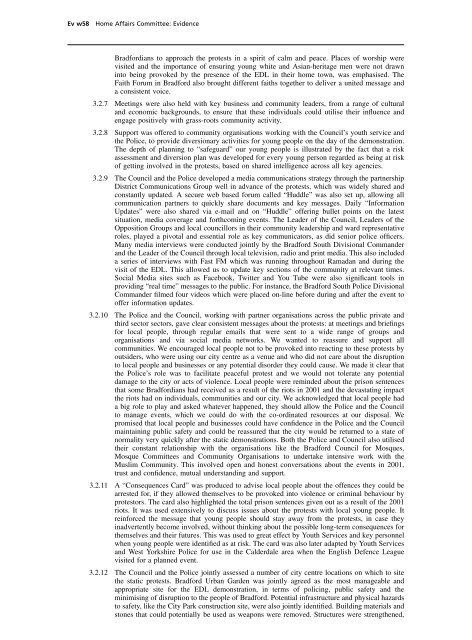Policing Large Scale Disorder: Lessons from the disturbances of ...
Policing Large Scale Disorder: Lessons from the disturbances of ...
Policing Large Scale Disorder: Lessons from the disturbances of ...
Create successful ePaper yourself
Turn your PDF publications into a flip-book with our unique Google optimized e-Paper software.
Ev w58 Home Affairs Committee: Evidence<br />
Bradfordians to approach <strong>the</strong> protests in a spirit <strong>of</strong> calm and peace. Places <strong>of</strong> worship were<br />
visited and <strong>the</strong> importance <strong>of</strong> ensuring young white and Asian-heritage men were not drawn<br />
into being provoked by <strong>the</strong> presence <strong>of</strong> <strong>the</strong> EDL in <strong>the</strong>ir home town, was emphasised. The<br />
Faith Forum in Bradford also brought different faiths toge<strong>the</strong>r to deliver a united message and<br />
a consistent voice.<br />
3.2.7 Meetings were also held with key business and community leaders, <strong>from</strong> a range <strong>of</strong> cultural<br />
and economic backgrounds, to ensure that <strong>the</strong>se individuals could utilise <strong>the</strong>ir influence and<br />
engage positively with grass-roots community activity.<br />
3.2.8 Support was <strong>of</strong>fered to community organisations working with <strong>the</strong> Council’s youth service and<br />
<strong>the</strong> Police, to provide diversionary activities for young people on <strong>the</strong> day <strong>of</strong> <strong>the</strong> demonstration.<br />
The depth <strong>of</strong> planning to “safeguard” our young people is illustrated by <strong>the</strong> fact that a risk<br />
assessment and diversion plan was developed for every young person regarded as being at risk<br />
<strong>of</strong> getting involved in <strong>the</strong> protests, based on shared intelligence across all key agencies.<br />
3.2.9 The Council and <strong>the</strong> Police developed a media communications strategy through <strong>the</strong> partnership<br />
District Communications Group well in advance <strong>of</strong> <strong>the</strong> protests, which was widely shared and<br />
constantly updated. A secure web based forum called “Huddle” was also set up, allowing all<br />
communication partners to quickly share documents and key messages. Daily “Information<br />
Updates” were also shared via e-mail and on “Huddle” <strong>of</strong>fering bullet points on <strong>the</strong> latest<br />
situation, media coverage and forthcoming events. The Leader <strong>of</strong> <strong>the</strong> Council, Leaders <strong>of</strong> <strong>the</strong><br />
Opposition Groups and local councillors in <strong>the</strong>ir community leadership and ward representative<br />
roles, played a pivotal and essential role as key communicators, as did senior police <strong>of</strong>ficers.<br />
Many media interviews were conducted jointly by <strong>the</strong> Bradford South Divisional Commander<br />
and <strong>the</strong> Leader <strong>of</strong> <strong>the</strong> Council through local television, radio and print media. This also included<br />
a series <strong>of</strong> interviews with Fast FM which was running throughout Ramadan and during <strong>the</strong><br />
visit <strong>of</strong> <strong>the</strong> EDL. This allowed us to update key sections <strong>of</strong> <strong>the</strong> community at relevant times.<br />
Social Media sites such as Facebook, Twitter and You Tube were also significant tools in<br />
providing “real time” messages to <strong>the</strong> public. For instance, <strong>the</strong> Bradford South Police Divisional<br />
Commander filmed four videos which were placed on-line before during and after <strong>the</strong> event to<br />
<strong>of</strong>fer information updates.<br />
3.2.10 The Police and <strong>the</strong> Council, working with partner organisations across <strong>the</strong> public private and<br />
third sector sectors, gave clear consistent messages about <strong>the</strong> protests: at meetings and briefings<br />
for local people, through regular emails that were sent to a wide range <strong>of</strong> groups and<br />
organisations and via social media networks. We wanted to reassure and support all<br />
communities. We encouraged local people not to be provoked into reacting to <strong>the</strong>se protests by<br />
outsiders, who were using our city centre as a venue and who did not care about <strong>the</strong> disruption<br />
to local people and businesses or any potential disorder <strong>the</strong>y could cause. We made it clear that<br />
<strong>the</strong> Police’s role was to facilitate peaceful protest and we would not tolerate any potential<br />
damage to <strong>the</strong> city or acts <strong>of</strong> violence. Local people were reminded about <strong>the</strong> prison sentences<br />
that some Bradfordians had received as a result <strong>of</strong> <strong>the</strong> riots in 2001 and <strong>the</strong> devastating impact<br />
<strong>the</strong> riots had on individuals, communities and our city. We acknowledged that local people had<br />
a big role to play and asked whatever happened, <strong>the</strong>y should allow <strong>the</strong> Police and <strong>the</strong> Council<br />
to manage events, which we could do with <strong>the</strong> co-ordinated resources at our disposal. We<br />
promised that local people and businesses could have confidence in <strong>the</strong> Police and <strong>the</strong> Council<br />
maintaining public safety and could be reassured that <strong>the</strong> city would be returned to a state <strong>of</strong><br />
normality very quickly after <strong>the</strong> static demonstrations. Both <strong>the</strong> Police and Council also utilised<br />
<strong>the</strong>ir constant relationship with <strong>the</strong> organisations like <strong>the</strong> Bradford Council for Mosques,<br />
Mosque Committees and Community Organisations to undertake intensive work with <strong>the</strong><br />
Muslim Community. This involved open and honest conversations about <strong>the</strong> events in 2001,<br />
trust and confidence, mutual understanding and support.<br />
3.2.11 A “Consequences Card” was produced to advise local people about <strong>the</strong> <strong>of</strong>fences <strong>the</strong>y could be<br />
arrested for, if <strong>the</strong>y allowed <strong>the</strong>mselves to be provoked into violence or criminal behaviour by<br />
protestors. The card also highlighted <strong>the</strong> total prison sentences given out as a result <strong>of</strong> <strong>the</strong> 2001<br />
riots. It was used extensively to discuss issues about <strong>the</strong> protests with local young people. It<br />
reinforced <strong>the</strong> message that young people should stay away <strong>from</strong> <strong>the</strong> protests, in case <strong>the</strong>y<br />
inadvertently become involved, without thinking about <strong>the</strong> possible long-term consequences for<br />
<strong>the</strong>mselves and <strong>the</strong>ir futures. This was used to great effect by Youth Services and key personnel<br />
when young people were identified as at risk. The card was also later adapted by Youth Services<br />
and West Yorkshire Police for use in <strong>the</strong> Calderdale area when <strong>the</strong> English Defence League<br />
visited for a planned event.<br />
3.2.12 The Council and <strong>the</strong> Police jointly assessed a number <strong>of</strong> city centre locations on which to site<br />
<strong>the</strong> static protests. Bradford Urban Garden was jointly agreed as <strong>the</strong> most manageable and<br />
appropriate site for <strong>the</strong> EDL demonstration, in terms <strong>of</strong> policing, public safety and <strong>the</strong><br />
minimising <strong>of</strong> disruption to <strong>the</strong> people <strong>of</strong> Bradford. Potential infrastructure and physical hazards<br />
to safety, like <strong>the</strong> City Park construction site, were also jointly identified. Building materials and<br />
stones that could potentially be used as weapons were removed. Structures were streng<strong>the</strong>ned,
















